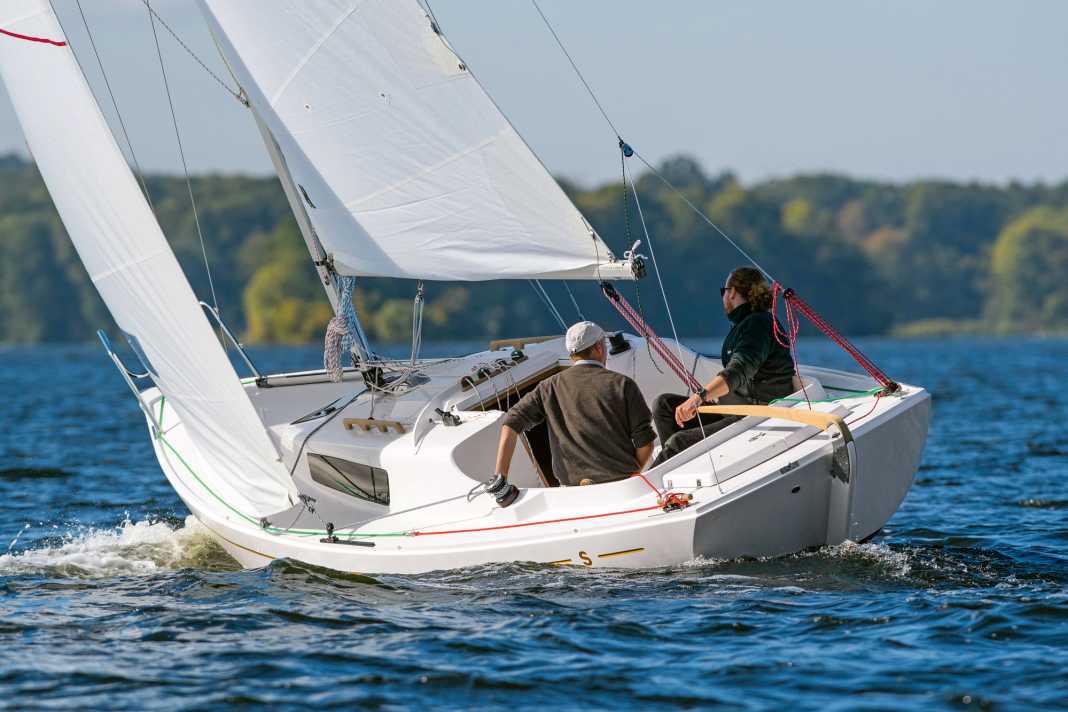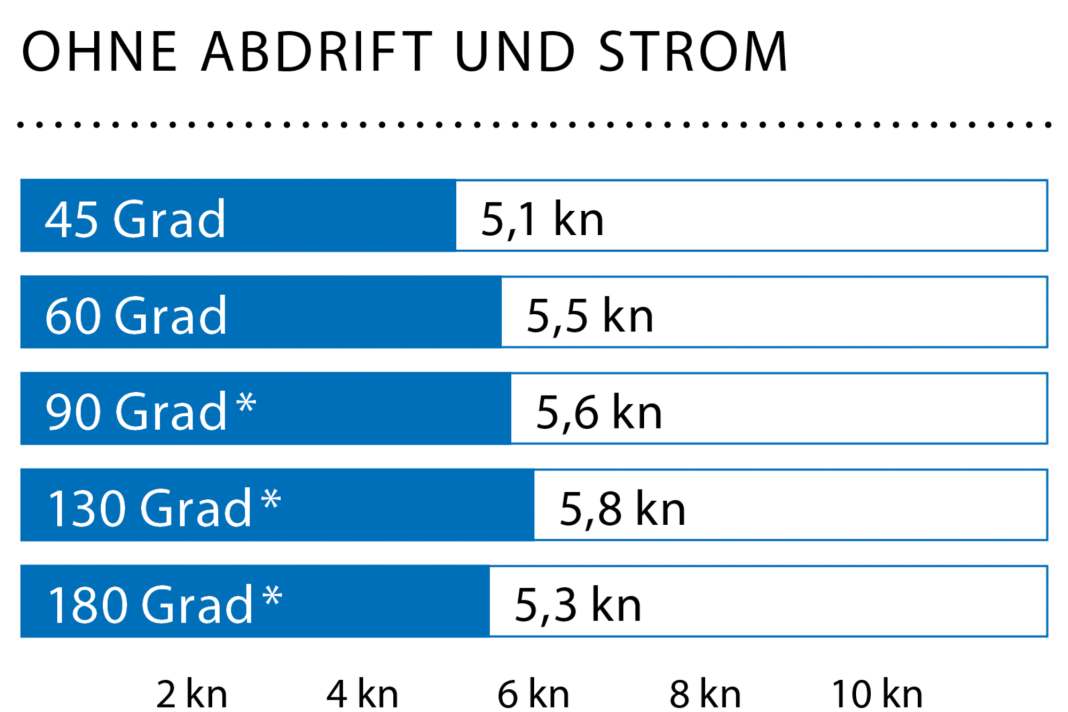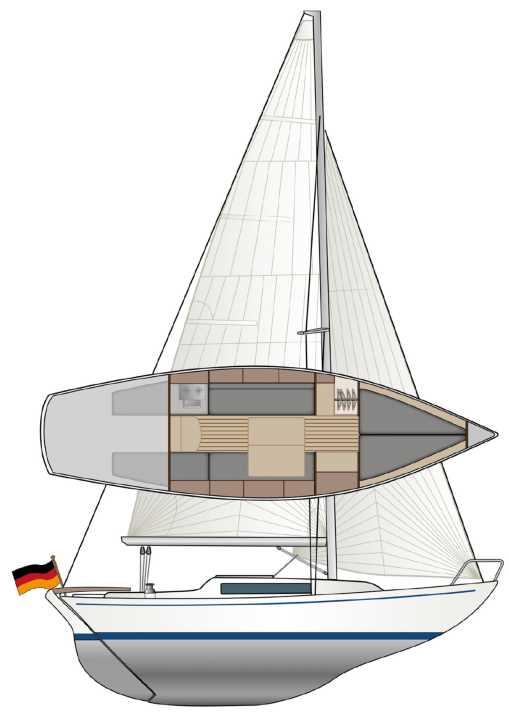





It's a little disconcerting because the boat looks very familiar. But the shiny gelcoat and details such as the glued-in windows without frames give it away: This is a new ship. The first new IF boat in 34 years was christened on Lake Wannsee at the end of September. Almost every sailor is familiar with the more than 50-year-old design, as 3500 of them were built and many are still cruising the lakes and seas. Peter Grönlund, founder and developer of the Seacamper motorboat and operator of a refit shipyard for IF boats, wants to build on this success and is now rebuilding the small classic. When a sailing enthusiast joined in as an investor and contributed around 100,000 euros for the mould construction, the dream of resurrecting the IF boat at Yacht Service in Szczecin became a reality.
So the construction number 1 is not just an old design in a new guise, its keel also contains the ballast of the IF that was used for mould construction, a kind of boatbuilding organ donation. Grönlund did this for practical reasons - after all, the cast-iron keel was left over - but also to be on the safe side with the weight, especially for the first construction number. The class associations are keeping a very close eye on his project. And so representatives from the German, Danish and Swedish class associations also attend the christening. The tone is friendly, but soon the measuring tape is pulled out and the new boat is closely scrutinised.
Famous ancestor
25 years after the great success of the Folkboat, the designer Tord Sundén revised his design and developed the International Folkboat - IF for short.
The biggest change was the building material: instead of wood, only GRP was used. This resulted in the most striking innovation, the smooth hull; the edges typical of the Folkeboot, which were created by the clinkered planking, were omitted due to the modern material. Sundén also changed the dimensions, but only very slightly: at 7.86 metres, the IF boat is 24 centimetres longer and, at 2.23 metres, three centimetres wider than the Folke. Both have a draught of 1.20 metres. The IF weighs 2.15 tonnes and is therefore 220 kilograms heavier than its famous predecessor, but has more ballast. This is also necessary as it has more sail area.
Also interesting:
At 16 square metres, the mainsail is actually one square metre smaller than on the Folke boat, but the IF has a large genoa, which at 15 square metres has more than twice the surface area of the Folke boat's small jib. The rig of the IF boat is made of aluminium. The decisive change, which has an impact on both comfort and safety, is the self-draining cockpit. In the Folkeboot, every rain shower and every sea overflow goes straight into the bilge, whereas in the IF boat it simply drains back outside. This means that the pump is no longer the most important piece of equipment on board, and the boat stays dry even in bad weather if the companionway is closed.
The IF boat was planned as a standardised class and built according to strict class regulations so that the boats can compete against each other on the regatta course with as equal conditions as possible. Nevertheless, there are some differences caused by the different propulsion concepts. Originally, an outboard motor is intended as the drive, which is driven in a shaft in the aft peak. When it is not needed, a small whisk can simply be pulled out of the shaft and placed crosswise in the storage space. The shaft is then closed. Larger outboards, however, do not fit crossways into the aft peak, but must remain in the water, which slows you down enormously, as the drive protrudes into the water next to the rudder blade. This is why many IF boats run the outboard on the transom.
There are also IFs with a built-in engine. In this case, the propeller is located in a cut-out in the rudder blade, the propeller well. This generates braking turbulence when sailing.
Small differences
The IF boat is now also 51 years old, and even the newest of the 3500 IFs built have been around for over 30 years. Grönlund's reasoning: Refurbishing the underwater hull and applying a new gelcoat would cost so many hours of labour that it would make more economic sense to build a new boat. Especially as he already had many small changes in mind, which could then be implemented. Despite the strict class rules, which also regulate the fixtures below deck down to the last detail, there were actually many improvements.
The superstructure windows, which now consist of a continuous pane of acrylic glass glued into a recess, immediately catch the eye; screws and aluminium frames are no longer required. The front hatch is also no longer a GRP moulding, but a real window. There is now an anchor locker at the bow, an enormous gain in comfort for cruising sailors. All other changes are less noticeable: the aft peak flaps are slightly smaller and no longer collide with the backstay, the coaming is more egonomically shaped, the forecastle boxes can be used better, the sea valves for the cockpit bilge pump are easy to reach and the deck-hull connection is laminated throughout. A small moat in the cockpit also ensures dry feet.
Under sail
We have an old IF boat belonging to one of Peter Grönlund's club mates with us as a reference for the test run on the Wannsee. The new IF has no engine, just a fitting at the stern into which a rigging strap can be hooked.
As soon as the sails get wind, the IF boat leans slightly to leeward. For the first 10 degrees the boat seems almost lean, but then the high ballast ratio becomes noticeable. In the gusts, only a few degrees of leeway are added. At just under 3 Beaufort, we are sailing at around five knots. The rudder provides good feedback and the IF is very agile despite the long keel and a lot of ballast. If you let go of the tiller downwind, it luffs slowly and loses speed, but sails straight ahead long enough for you to take care of the trim. Sailing downwind is very comfortable with the high coaming behind you and a clear view of the genoa. This allows you to steer very intuitively along the wind edge.
When tacking, the IF goes quickly through the wind and hardly loses any speed if well coordinated with the foresailor. At a 90 degree tacking angle, the boat sails fast, a few degrees more height is possible, but this is associated with a significant loss of speed. The value is still very good for the genoa, which is sheeted all the way out.
The hoisting point of the smaller jib is run on the inside of the superstructure, but the rails are not yet fitted to the new IF; this would allow a few degrees more height. In comparison, the new IF runs higher and is about half a knot faster than the older comparison boat.
In addition to the newer sails, the inboard motor on the other boat could also have a negative effect on performance. Otherwise, the boats are identical. However, due to the more modern design with inboard hull, it is quite possible that the new IF is stiffer and warps less as soon as there is pressure in the rig. Downwind with a spinnaker, the speed over the ground stabilises at just over 5 knots. We set the speed record of the day in a small gust of 5.8 knots with a clear wind. The new boat is also clearly superior to the old one on the spinnaker courses.
The interior is beautifully and robustly carpentered from plywood with a silk matt lacquered mahogany veneer; the top and sides consist of a thin inner shell. The lighting is indirect with LED lamps. Apart from a cooker, however, there is hardly any comfort. There is plenty of storage space.
The basic version of this pretty classic costs 63,430 euros. If you buy additional electrics with charger, battery, lighting and position lights, compass and an outboard motor for an extra charge, you get a new IF boat that is ready to sail - a fair price for the quality of the workmanship, branded fittings and the very decent sailing characteristics.
The measured values for testing the IF boat




The IF boat in detail

Technical data of the IF boat
- Design engineer: Tord Sundén
- CE design category: C
- Torso length: 7,86 m
- Width: 2,23 m
- Depth: 1,20 m
- Weight: 2,15 t
- Ballast/proportion: 1,25 t/58 %
- Mainsail: 16,00 m²
- Genoa: 15,00 m²
Hull and deck construction
- Hull: Polyester full laminate, outer two layers with vinyl ester
- Deck: Polyester sandwich with Divinycell core
Price and shipyard
- Base price ex shipyard: 63,430 € incl. VAT.
- Guarantee: 2 years
As of 07/2024, how the prices shown are defined can be found here!
Shipyard
Seacamper, Sakrower Kirchweg 18, 14089 Berlin
Distribution
www.if-boat.com and www.if-boat.nl (Dealer Netherlands)
YACHT assessment of the IF boat
Over 50 years ago, the IF boat was marketed as a family cruiser and regatta boat. Nowadays, this size of boat is more of a daysailer, but everything you need for longer trips is on board. The IF is always seaworthy
Design and concept
- + Improved deck-hull connection
- + trailer bar
- + High ballast content
Sailing performance and trim
- + Good sailing characteristics
- + Mast can be trimmed with backstay
Living and finishing quality
- + Large bow berth
- + Plenty of storage space
- - No standing height
Equipment and technology
- + Easy to operate and trim rig
- + Brand fittings
- + built-in machine possible (option)
The article first appeared in YACHT 25/2018 and has been updated for the online version.

